Ocean–Ice Sheet Coupling in the Totten Glacier Area, East Antarctica: Analysis of the Feedbacks and Their Response to a Sudden Ocean Warming
Abstract
1. Introduction
2. Materials and Methods
2.1. Ice Flow Model: BISICLES
The BISICLES Configuration
2.2. Ocean and Sea Ice Model: NEMO3.6-LIM3
The Totten24 Model Configuration
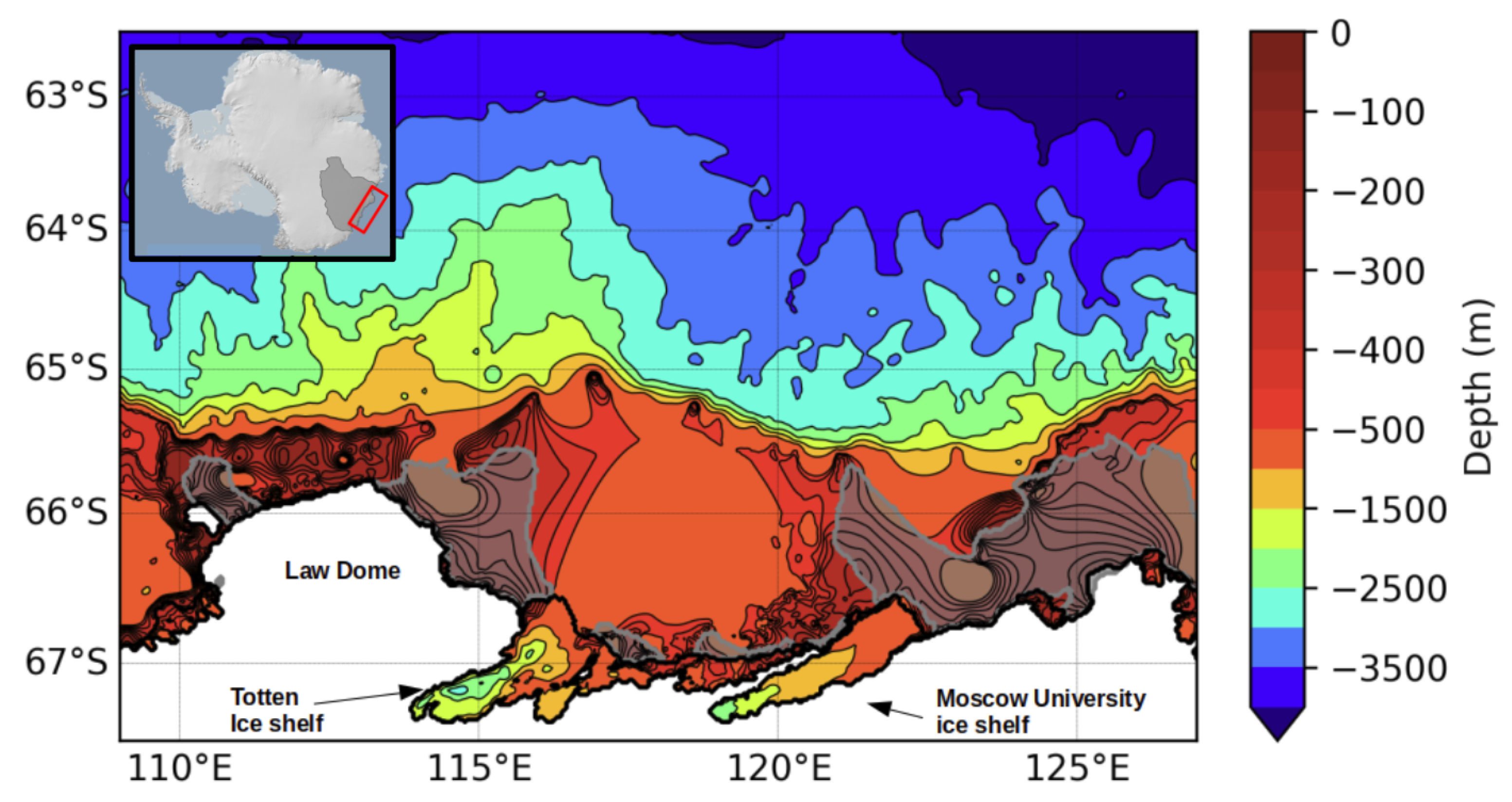
2.3. Initialisation and Coupling Interface
2.4. Experimental Design
3. Results
3.1. Ocean–Ice Sheet Coupling Effects on the Ice Shelf Cavities
3.2. Ocean–Ice Sheet Coupling Impact on the Ocean Properties and Sea Ice over the Continental Shelf
3.3. Sensitivity of the Ocean–Ice Sheet Coupling Response to Sudden Warming
4. Discussion and Conclusions
Author Contributions
Funding
Data Availability Statement
Acknowledgments
Conflicts of Interest
Abbreviations
| BISICLES | Berkeley Ice Sheet Initiative for Climate at Extreme Scales model |
| ERA5 | fifth-generation ECMWF atmospheric reanalysis |
| EVP | elastic–viscous–plastic |
| FESOM | Finite-Element volumE Sea ice–Ocean Model |
| GCMs | Global Climate Models |
| LIM | Louvain–la Neuve sea ice model |
| MAR | Modèle Atmosphérique Régional |
| mCDW | modified Circumpolar Deep Water |
| MITgcm | Massachusetts Institute of Technology general circulation model |
| MUIS | Moscow University Ice Shelf |
| OPA | Océan Parallélisé |
| RCMs | Regional Climate Models |
| RIMBAY | Revised Ice Model Based on frAnk pattYn |
| SSH | sea surface elevation |
| TIS | Totten Ice Shelf |
| TKE | Turbulent Kinetic Energy |
Appendix A
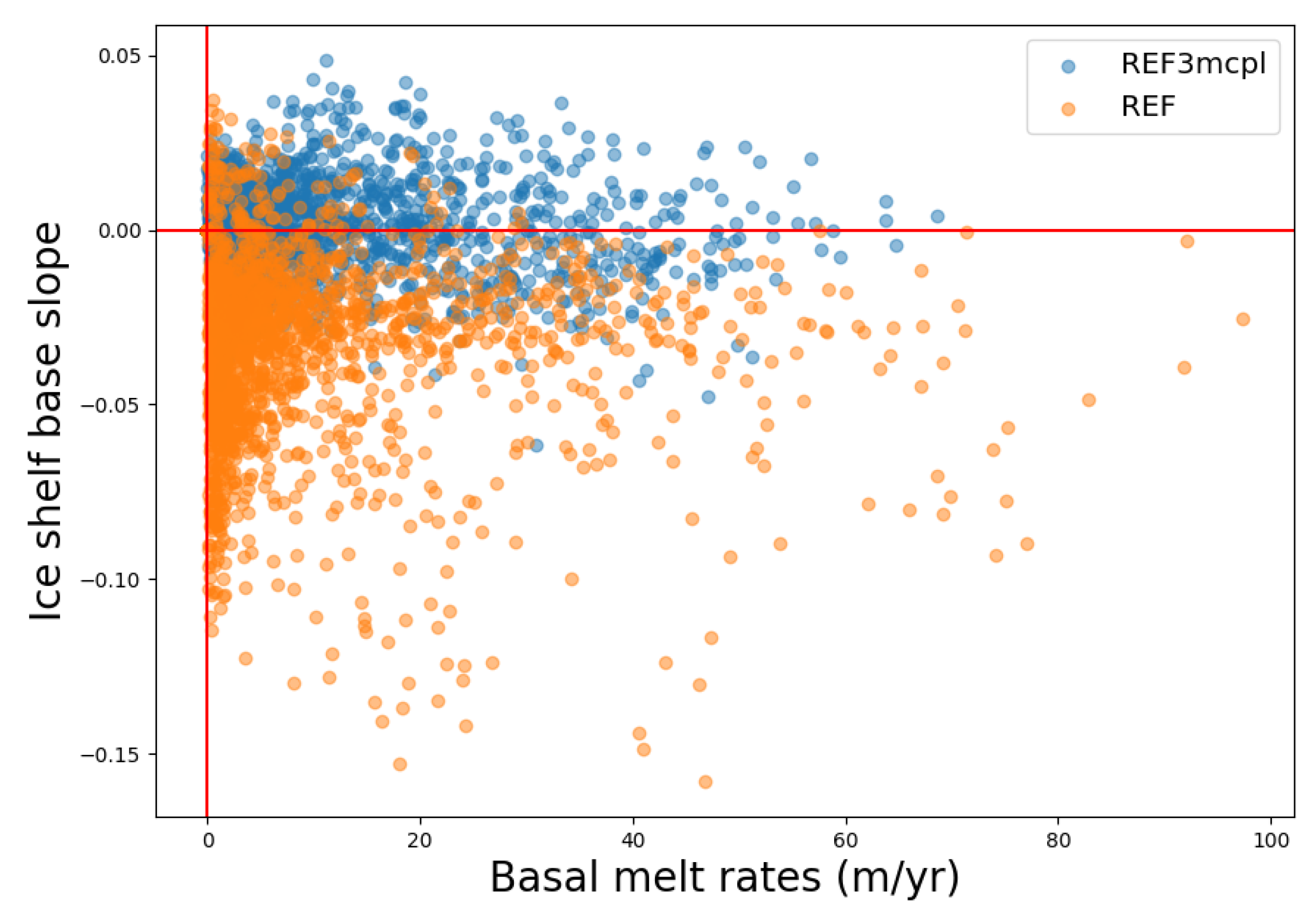
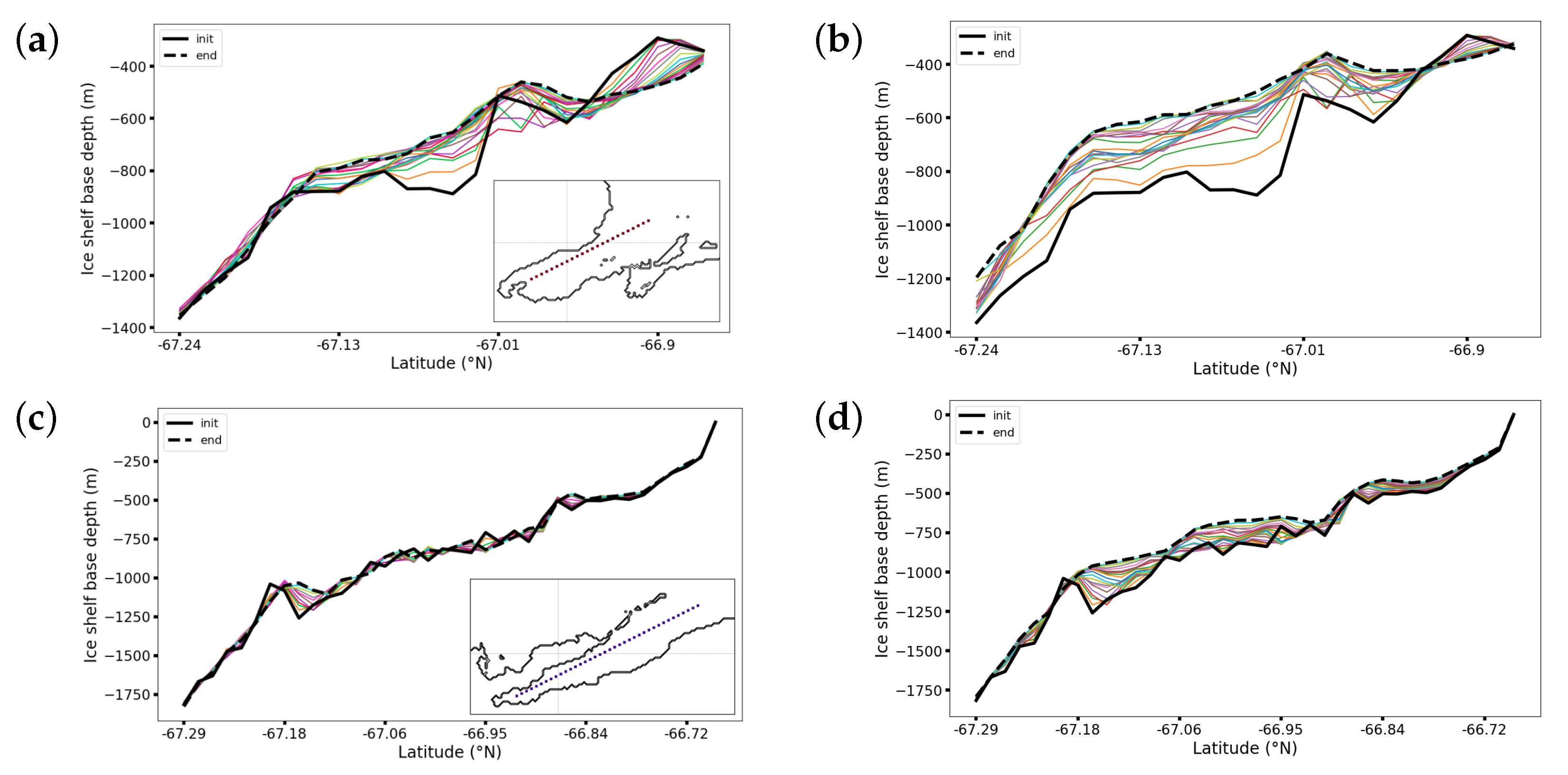
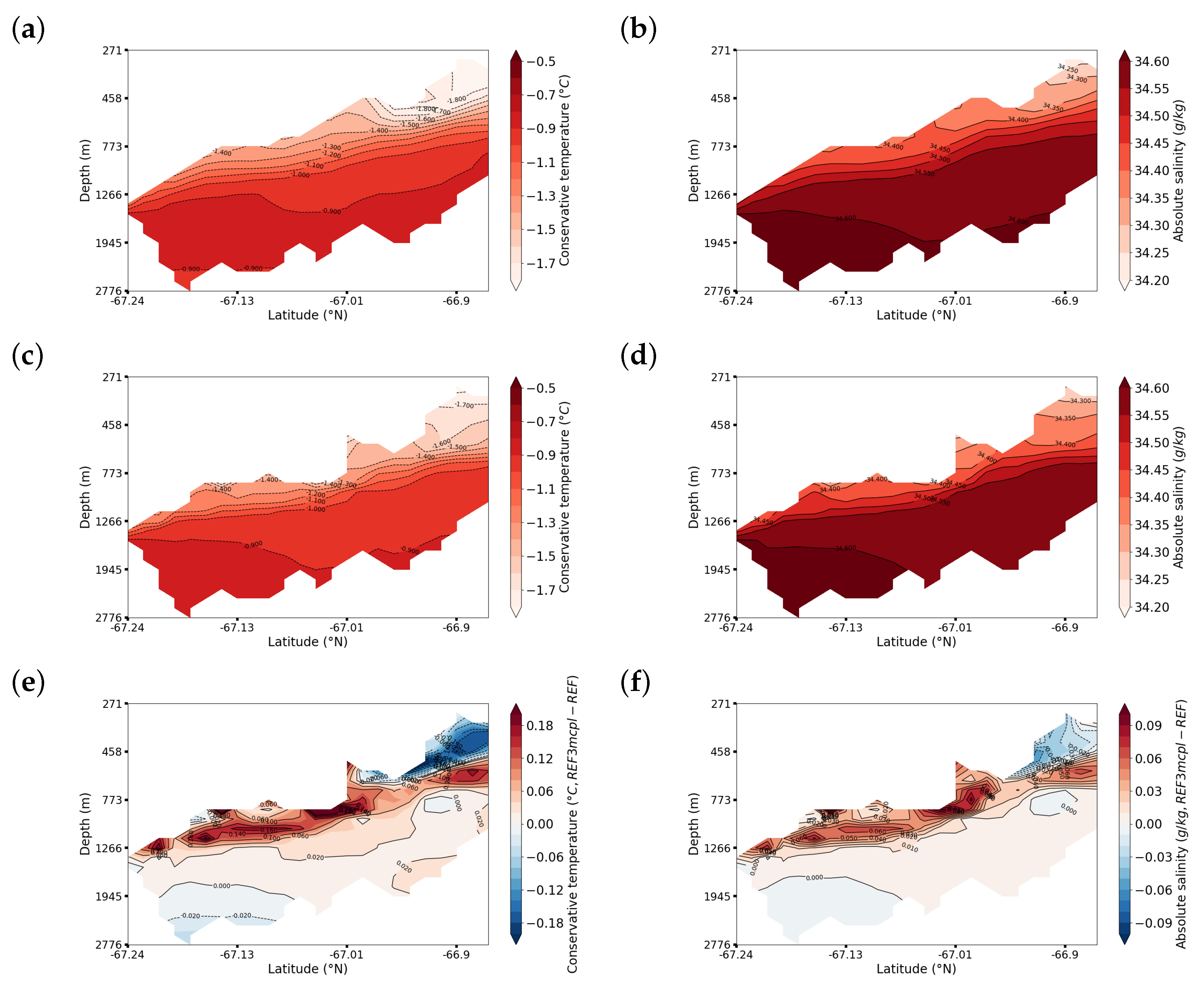

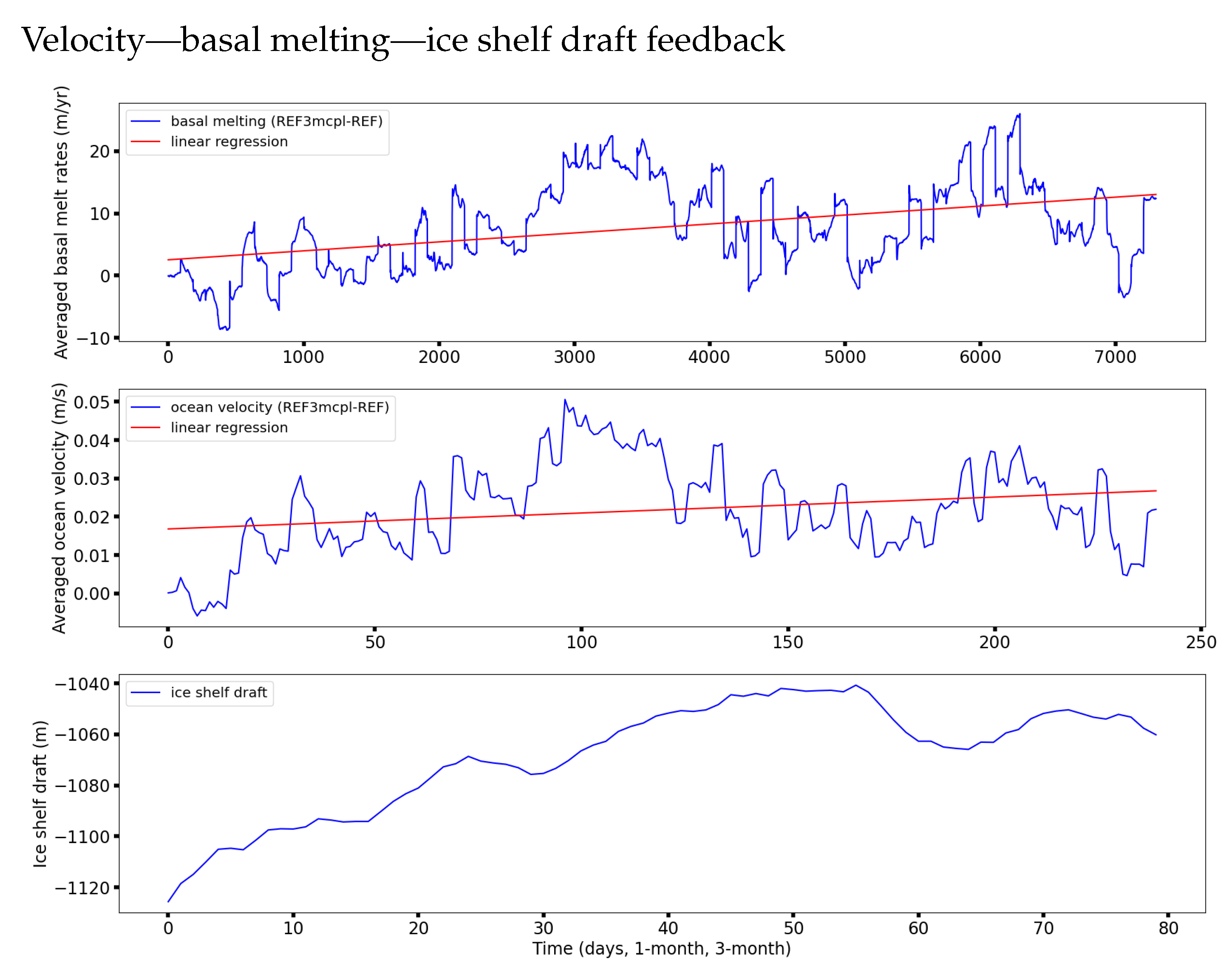
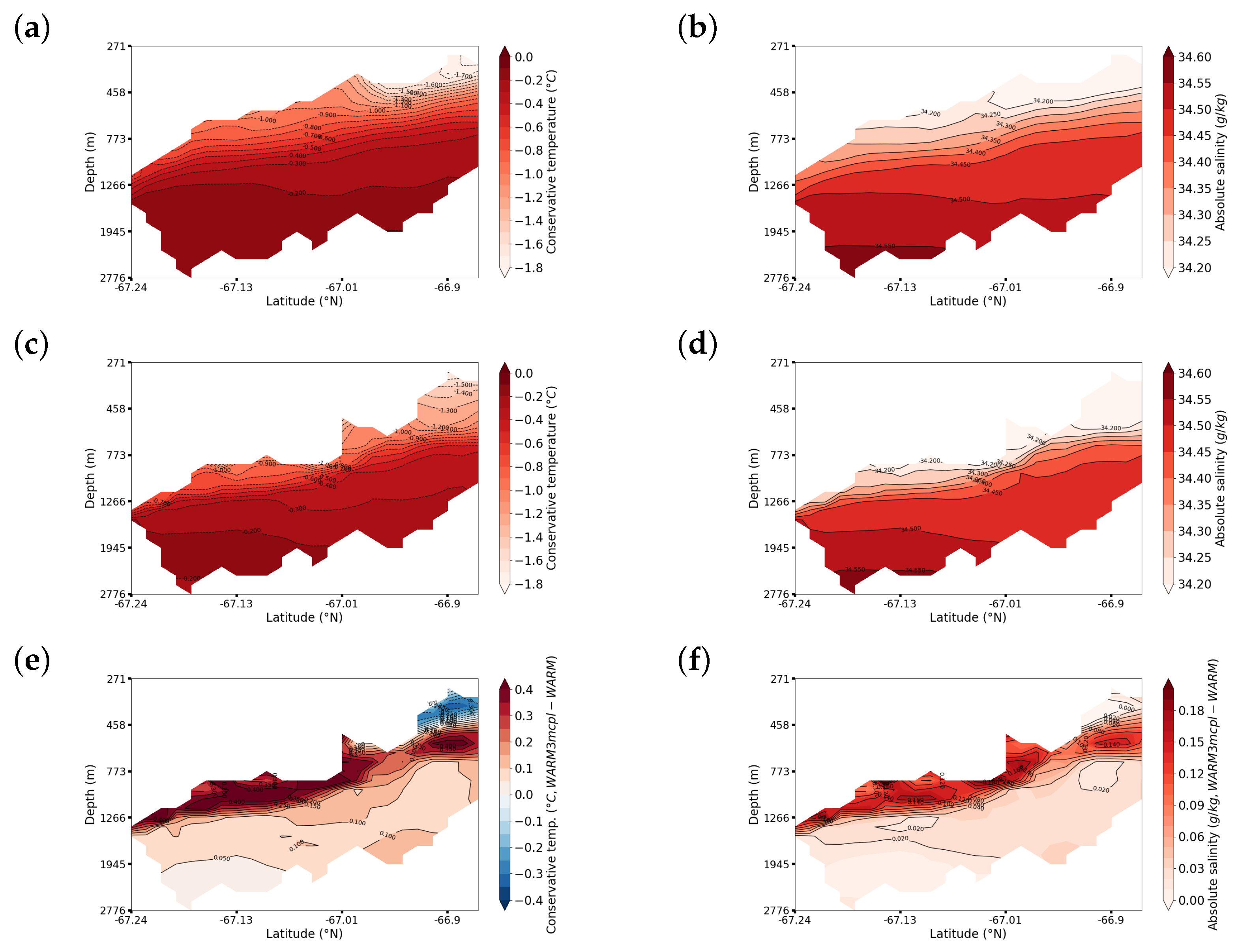

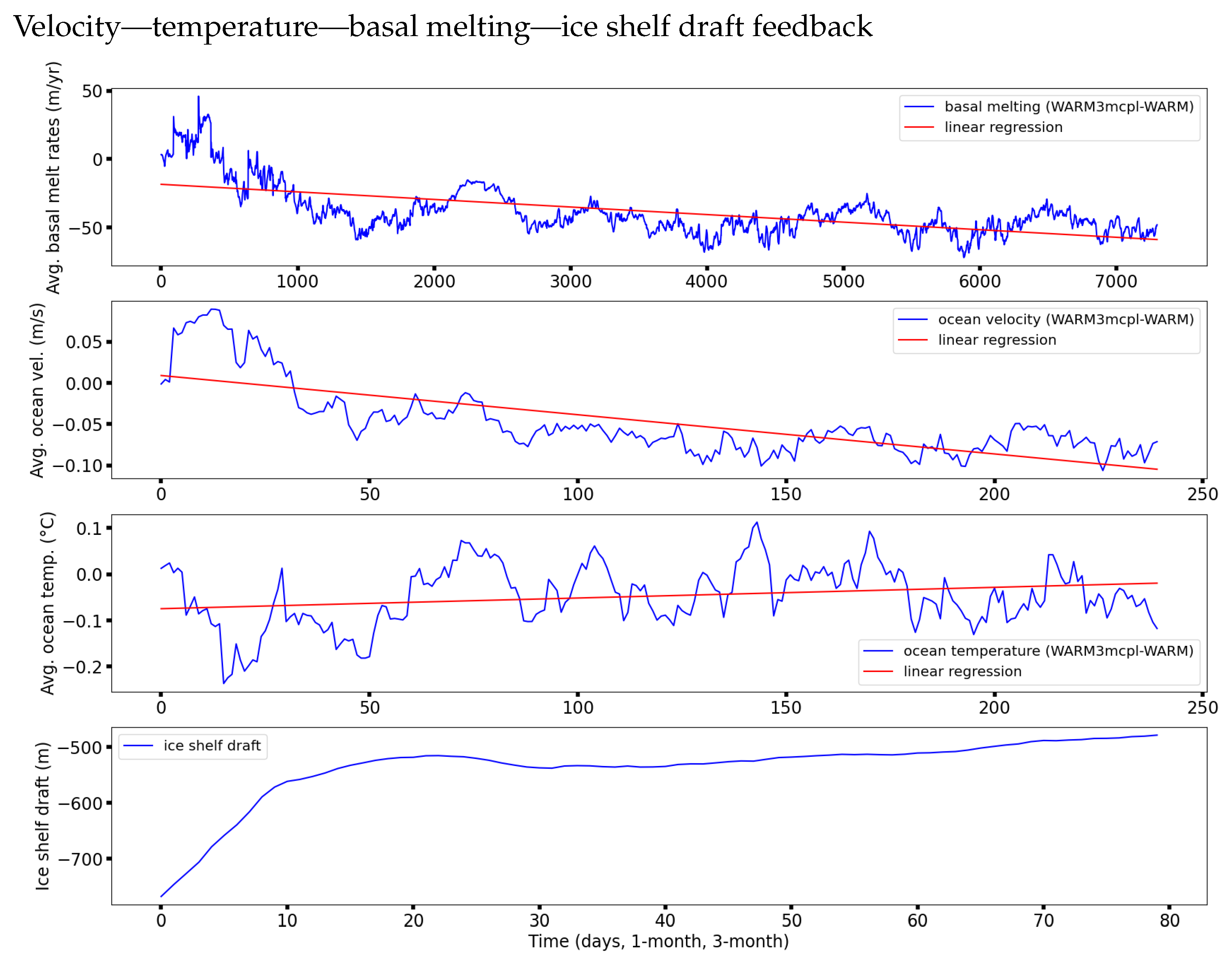
References
- Rignot, E. Changes in ice dynamics and mass balance of the Antarctic ice sheet. Philos. Trans. R. Soc. A Math. Phys. Eng. Sci. 2006, 364, 1637–1655. [Google Scholar] [CrossRef] [PubMed]
- Li, X.; Rignot, E.; Morlighem, M.; Mouginot, J.; Scheuchl, B. Grounding line retreat of Totten Glacier, East Antarctica, 1996 to 2013. Geophys. Res. Lett. 2015, 42, 8049–8056. [Google Scholar] [CrossRef]
- Morlighem, M.; Rignot, E.; Binder, T.; Blankenship, D.; Drews, R.; Eagles, G.; Eisen, O.; Forsberg, R.; Fretwell, P.; Goel, V.; et al. Deep glacial troughs and stabilizing ridges unveiled beneath the margins of the Antarctic ice sheet. Nat. Geosci. 2020, 13, 132–137. [Google Scholar] [CrossRef]
- Sun, S.; Pattyn, F.; Simon, E.G.; Albrecht, T.; Cornford, S.; Calov, R.; Dumas, C.; Gillet-Chaulet, F.; Goelzer, H.; Golledge, N.R.; et al. Antarctic ice sheet response to sudden and sustained ice-shelf collapse (ABUMIP). J. Glaciol. 2020, 66, 891–904. [Google Scholar] [CrossRef]
- Khazendar, A.; Schodlok, M.; Fenty, I.; Ligtenberg, S.; Rignot, E.; van den Broeke, M. Observed thinning of Totten Glacier is linked to coastal polynya variability. Nat. Commun. 2013, 4, 2857. [Google Scholar] [CrossRef] [PubMed]
- Aitken, A.R.A.; Roberts, J.L.; Ommen, T.D.v.; Young, D.A.; Golledge, N.R.; Greenbaum, J.S.; Blankenship, D.D.; Siegert, M.J. Repeated large-scale retreat and advance of Totten Glacier indicated by inland bed erosion. Nature 2016, 533, 385–389. [Google Scholar] [CrossRef]
- Li, X.; Rignot, E.; Mouginot, J.; Scheuchl, B. Ice flow dynamics and mass loss of Totten Glacier, East Antarctica, from 1989 to 2015. Geophys. Res. Lett. 2016, 43, 6366–6373. [Google Scholar] [CrossRef]
- Rignot, E.; Mouginot, J.; Scheuchl, B.; van den Broeke, M.; van Wessem, M.J.; Morlighem, M. Four decades of Antarctic Ice Sheet mass balance from 1979–2017. Proc. Natl. Acad. Sci. USA 2019, 116, 1095–1103. [Google Scholar] [CrossRef]
- Gwyther, D.E.; Galton-Fenzi, B.K.; Hunter, J.R.; Roberts, J.L. Simulated melt rates for the Totten and Dalton ice shelves. Ocean Sci. 2014, 10, 267–279. [Google Scholar] [CrossRef]
- Rintoul, S.R.; Silvano, A.; Pena-Molino, B.; van Wijk, E.; Rosenberg, M.; Greenbaum, J.S.; Blankenship, D.D. Ocean heat drives rapid basal melt of the Totten Ice Shelf. Sci. Adv. 2016, 2. [Google Scholar] [CrossRef]
- Roberts, J.; Galton-Fenzi, B.K.; Paolo, F.S.; Donnelly, C.; Gwyther, D.E.; Padman, L.; Young, D.; Warner, R.; Greenbaum, J.; Fricker, H.A.; et al. Ocean forced variability of Totten Glacier mass loss. Geol. Soc. Lond. Spec. Publ. 2018, 461, 175–186. [Google Scholar] [CrossRef]
- Silvano, A.; Rintoul, S.R.; Peña-Molino, B.; Williams, G.D. Distribution of water masses and meltwater on the continental shelf near the Totten and Moscow University ice shelves. J. Geophys. Res. Ocean. 2017, 122, 2050–2068. [Google Scholar] [CrossRef]
- Silvano, A.; Rintoul, S.R.; Kusahara, K.; Peña-Molino, B.; van Wijk, E.; Gwyther, D.E.; Williams, G.D. Seasonality of Warm Water Intrusions Onto the Continental Shelf Near the Totten Glacier. J. Geophys. Res. Ocean. 2019, 124, 4272–4289. [Google Scholar] [CrossRef]
- Greene, C.A.; Blankenship, D.D.; Gwyther, D.E.; Silvano, A.; van Wijk, E. Wind causes Totten Ice Shelf melt and acceleration. Sci. Adv. 2017, 3. [Google Scholar] [CrossRef] [PubMed]
- Gwyther, D.E.; O’Kane, T.J.; Galton-Fenzi, B.K.; Monselesan, D.P.; Greenbaum, J.S. Intrinsic processes drive variability in basal melting of the Totten Glacier Ice Shelf. Nat. Commun. 2018, 9, 3141. [Google Scholar] [CrossRef]
- Goldberg, D.N.; Little, C.M.; Sergienko, O.V.; Gnanadesikan, A.; Hallberg, R.; Oppenheimer, M. Investigation of land ice-ocean interaction with a fully coupled ice-ocean model: 1. Model description and behavior. J. Geophys. Res. Earth Surf. 2012, 117. [Google Scholar] [CrossRef]
- Dupont, T.K.; Alley, R.B. Assessment of the importance of ice-shelf buttressing to ice-sheet flow. Geophys. Res. Lett. 2005, 32. [Google Scholar] [CrossRef]
- Dupont, T.K.; Alley, R.B. Role of small ice shelves in sea-level rise. Geophys. Res. Lett. 2006, 33. [Google Scholar] [CrossRef]
- Holland, P.R.; Feltham, D.L.; Jenkins, A. Ice Shelf Water plume flow beneath Filchner-Ronne Ice Shelf, Antarctica. J. Geophys. Res. Ocean. 2007, 112. [Google Scholar] [CrossRef]
- Jenkins, A. The Impact of Melting Ice on Ocean Waters. J. Phys. Oceanogr. 1999, 29, 2370–2381. [Google Scholar] [CrossRef]
- Nicholls, K.W.; Østerhus, S.; Makinson, K.; Gammelsrød, T.; Fahrbach, E. Ice-ocean processes over the continental shelf of the southern Weddell Sea, Antarctica: A review. Rev. Geophys. 2009, 47. [Google Scholar] [CrossRef]
- Schodlok, M.P.; Menemenlis, D.; Rignot, E.; Studinger, M. Sensitivity of the ice-shelf/ocean system to the sub-ice-shelf cavity shape measured by NASA IceBridge in Pine Island Glacier, West Antarctica. Ann. Glaciol. 2012, 53, 156–162. [Google Scholar] [CrossRef]
- Swingedouw, D.; Fichefet, T.; Huybrechts, P.; Goosse, H.; Driesschaert, E.; Loutre, M.F. Antarctic ice-sheet melting provides negative feedbacks on future climate warming. Geophys. Res. Lett. 2008, 35. [Google Scholar] [CrossRef]
- Timmermann, R.; Goeller, S. Response to Filchner–Ronne Ice Shelf cavity warming in a coupled ocean–ice sheet model—Part 1: The ocean perspective. Ocean Sci. 2017, 13, 765–776. [Google Scholar] [CrossRef]
- Pelle, T.; Morlighem, M.; Nakayama, Y.; Seroussi, H. Widespread Grounding Line Retreat of Totten Glacier, East Antarctica, Over the 21st Century. Geophys. Res. Lett. 2021, 48, e2021GL093213. [Google Scholar] [CrossRef]
- Naughten, K.A.; De Rydt, J.; Rosier, S.H.R.; Jenkins, A.; Holland, P.R.; Ridley, J.K. Two-timescale response of a large Antarctic ice shelf to climate change. Nat. Commun. 2021, 12, 1991. [Google Scholar] [CrossRef]
- Smith, R.S.; Mathiot, P.; Siahaan, A.; Lee, V.; Cornford, S.L.; Gregory, J.M.; Payne, A.J.; Jenkins, A.; Holland, P.R.; Ridley, J.K.; et al. Coupling the U.K. Earth System Model to Dynamic Models of the Greenland and Antarctic Ice Sheets. J. Adv. Model. Earth Syst. 2021, 13, e2021MS002520. [Google Scholar] [CrossRef]
- Pelletier, C.; Fichefet, T.; Goosse, H.; Haubner, K.; Helsen, S.; Huot, P.V.; Kittel, C.; Klein, F.; Le clec’h, S.; van Lipzig, N.P.M.; et al. PARASO, a circum-Antarctic fully-coupled ice-sheet—Ocean—Sea-ice—Atmosphere—Land model involving f.ETISh1.7, NEMO3.6, LIM3.6, COSMO5.0 and CLM4.5. Geosci. Model Dev. 2022, 15, 553–594. [Google Scholar] [CrossRef]
- Seroussi, H.; Nakayama, Y.; Larour, E.; Menemenlis, D.; Morlighem, M.; Rignot, E.; Khazendar, A. Continued retreat of Thwaites Glacier, West Antarctica, controlled by bed topography and ocean circulation. Geophys. Res. Lett. 2017, 44, 6191–6199. [Google Scholar] [CrossRef]
- Huot, P.V.; Fichefet, T.; Jourdain, N.C.; Mathiot, P.; Rousset, C.; Kittel, C.; Fettweis, X. Influence of ocean tides and ice shelves on ocean–ice interactions and dense shelf water formation in the D’Urville Sea, Antarctica. Ocean Model. 2021, 162, 101794. [Google Scholar] [CrossRef]
- Jenkins, A.; Nicholls, K.W.; Corr, H.F.J. Observation and Parameterization of Ablation at the Base of Ronne Ice Shelf, Antarctica. J. Phys. Oceanogr. 2010, 40, 2298–2312. [Google Scholar] [CrossRef]
- Döscher, R.; Acosta, M.; Alessandri, A.; Anthoni, P.; Arneth, A.; Arsouze, T.; Bergmann, T.; Bernadello, R.; Bousetta, S.; Caron, L.P.; et al. The EC-Earth3 Earth System Model for the Climate Model Intercomparison Project 6. Geosci. Model Dev. Discuss. 2022, 15, 2973–3020. [Google Scholar] [CrossRef]
- Cornford, S.L.; Martin, D.F.; Graves, D.T.; Ranken, D.F.; Le Brocq, A.M.; Gladstone, R.M.; Payne, A.J.; Ng, E.G.; Lipscomb, W.H. Adaptive mesh, finite volume modeling of marine ice sheets. J. Comput. Phys. 2013, 232, 529–549. [Google Scholar] [CrossRef]
- Schoof, C.; Hindmarsh, R.C.A. Thin-Film Flows with Wall Slip: An Asymptotic Analysis of Higher Order Glacier Flow Models. Q. J. Mech. Appl. Math. 2010, 63, 73–114. [Google Scholar] [CrossRef]
- Tsai, V.C.; Stewart, A.L.; Thompson, A.F. Marine ice-sheet profiles and stability under Coulomb basal conditions. J. Glaciol. 2015, 61, 205–215. [Google Scholar] [CrossRef]
- Seroussi, H.; Morlighem, M. Representation of basal melting at the grounding line in ice flow models. Cryosphere 2018, 12, 3085–3096. [Google Scholar] [CrossRef]
- Zwally, H.J.; Giovinetto, M.B.; Beckley, M.A.; Saba, J.J.L. Antarctic and Greenland drainage systems. (Tech. Rep.): GSFC Cryospheric Sciences Laboratory, 2012. [Google Scholar]
- Brunt, K.M.; Neumann, T.A.; Smith, B.E. Assessment of ICESat-2 Ice Sheet Surface Heights, Based on Comparisons over the Interior of the Antarctic Ice Sheet. Geophys. Res. Lett. 2019, 46, 13072–13078. [Google Scholar] [CrossRef]
- Morlighem, M. MEaSUREs BedMachine Antarctica, Version 2 [Bathymetry, Ice Thickness]. 2020. Available online: https://nsidc.org/data/nsidc-0756/versions/2 (accessed on 28 September 2020).
- MacAyeal, D.R. A tutorial on the use of control methods in ice-sheet modeling. J. Glaciol. 1993, 39, 91–98. [Google Scholar] [CrossRef]
- Morlighem, M.; Rignot, E.; Seroussi, H.; Larour, E.; Ben Dhia, H.; Aubry, D. Spatial patterns of basal drag inferred using control methods from a full-Stokes and simpler models for Pine Island Glacier, West Antarctica. Geophys. Res. Lett. 2010, 37. [Google Scholar] [CrossRef]
- Rignot, E.; Velicogna, I.; van den Broeke, M.R.; Monaghan, A.; Lenaerts, J.T.M. Acceleration of the contribution of the Greenland and Antarctic ice sheets to sea level rise. Geophys. Res. Lett. 2011, 38. [Google Scholar] [CrossRef]
- Mouginot, J.; Rignot, E.; Scheuchl, B. Continent-Wide, Interferometric SAR Phase, Mapping of Antarctic Ice Velocity. Geophys. Res. Lett. 2019, 46, 9710–9718. [Google Scholar] [CrossRef]
- Kittel, C.; Amory, C.; Agosta, C.; Jourdain, N.C.; Hofer, S.; Delhasse, A.; Doutreloup, S.; Huot, P.V.; Lang, C.; Fichefet, T.; et al. Diverging future surface mass balance between the Antarctic ice shelves and grounded ice sheet. Cryosphere 2021, 15, 1215–1236. [Google Scholar] [CrossRef]
- Van Achter, G.; Fichefet, T.; Goosse, H.; Moreno-Chamarro, E. Influence of fast ice on future ice shelf melting in the Totten Glacier area, East Antarctica. Cryosphere 2022, 16, 4745–4761. [Google Scholar] [CrossRef]
- Madec, G. NEMO Ocean Engine; Note du Pole de modelisation; Institut Pierre-Simon Laplace (IPSL): Guyancourt, France, 2008; No 27, ISSN No 1288-1619. [Google Scholar]
- Vancoppenolle, M.; Fichefet, T.; Goosse, H.; Bouillon, S.; Madec, G.; Maqueda, M. Simulating the mass balance and salinity of Arctic and Antarctic sea ice. 1. Model description and validation. Ocean Model. 2009, 27, 33–53. [Google Scholar] [CrossRef]
- Rousset, C.; Vancoppenolle, M.; Madec, G.; Fichefet, T.; Flavoni, S.; Barthélemy, A.; Benshila, R.; Chanut, J.; Levy, C.; Masson, S.; et al. The Louvain-La-Neuve sea ice model LIM3.6: Global and regional capabilities. Geosci. Model Dev. 2015, 8, 2991–3005. [Google Scholar] [CrossRef]
- Lecomte, O.; Goosse, H.; Fichefet, T.; de Lavergne, C.; Barthélemy, A.; Zunz, V. Vertical ocean heat redistribution sustaining sea-ice concentration trends in the Ross Sea. Nat. Commun. 2017, 8, 258. [Google Scholar] [CrossRef]
- Hutchinson, K.; Deshayes, J.; Éthé, C.; Rousset, C.; de Lavergne, C.; Vancoppenolle, M.; Jourdain, N.C.; Mathiot, P. Improving Antarctic Bottom Water precursors in NEMO for climate applications. EGUsphere 2023, 2023, 1–28. [Google Scholar] [CrossRef]
- Jourdain, N.C.; Mathiot, P.; Merino, N.; Durand, G.; Le Sommer, J.; Spence, P.; Dutrieux, P.; Madec, G. Ocean circulation and sea-ice thinning induced by melting ice shelves in the Amundsen Sea. J. Geophys. Res. Ocean. 2017, 122, 2550–2573. [Google Scholar] [CrossRef]
- Van Achter, G.; Fichefet, T.; Goosse, H.; Pelletier, C.; Sterlin, J.; Huot, P.V.; Lemieux, J.F.; Fraser, A.D.; Haubner, K.; Porter-Smith, R. Modelling landfast sea ice and its influence on ocean–ice interactions in the area of the Totten Glacier, East Antarctica. Ocean Model. 2022, 169, 101920. [Google Scholar] [CrossRef]
- Arakawa, A. Computational design for long-term numerical integration of the equations of fluid motion: Two-dimensional incompressible flow. Part I. J. Comput. Phys. 1966, 1, 119–143. [Google Scholar] [CrossRef]
- Roquet, F.; Williams, G.; Hindell, M.A.; Harcourt, R.; McMahon, C.; Guinet, C.; Charrassin, J.B.; Reverdin, G.; Boehme, L.; Lovell, P.; et al. A Southern Indian Ocean database of hydrographic profiles obtained with instrumented elephant seals. Sci. Data 2014, 1, 140028. [Google Scholar] [CrossRef] [PubMed]
- Bruno, L.; Tréguier, A.M.; Madec, G.; Garnier, V. Free Surface and Variable Volume in the NEMO Code. 2007. Available online: https://zenodo.org/record/3244182#.ZB12zvZByUk (accessed on 14 February 2023).
- Bougeault, P.; Lacarrere, P. Parameterization of Orography-Induced Turbulence in a Mesobeta–Scale Model. Mon. Weather Rev. 1989, 117, 1872–1890. [Google Scholar] [CrossRef]
- Gaspar, P.; Grégoris, Y.; Lefevre, J.M. A simple eddy kinetic energy model for simulations of the oceanic vertical mixing: Tests at station Papa and long-term upper ocean study site. J. Geophys. Res. Ocean. 1990, 95, 16179–16193. [Google Scholar] [CrossRef]
- Madec, G.; Delecluse, P.; Imbard, M.; Levy, C. OPA 8.1 Ocean General Circulation Model Reference Manual. Institut Pierre Simon Laplace (IPSL): Guyancourt, France, 1998. [Google Scholar]
- Massonnet, F.; Goosse, H.; Fichefet, T.; Counillon, F. Calibration of sea ice dynamic parameters in an ocean-sea ice model using an ensemble Kalman filter. J. Geophys. Res. Ocean. 2014, 119, 4168–4184. [Google Scholar] [CrossRef]
- Bouillon, S.; Morales Maqueda, M.A.; Legat, V.; Fichefet, T. An elastic–viscous–plastic sea ice model formulated on Arakawa B and C grids. Ocean Model. 2009, 27, 174–184. [Google Scholar] [CrossRef]
- Bitz, C.M.; Holland, M.M.; Weaver, A.J.; Eby, M. Simulating the ice-thickness distribution in a coupled climate model. J. Geophys. Res. Ocean. 2001, 106, 2441–2463. [Google Scholar] [CrossRef]
- Mathiot, P.; Jenkins, A.; Harris, C.; Madec, G. Explicit representation and parametrised impacts of under ice shelf seas in the z* coordinate ocean model NEMO 3.6. Geosci. Model Dev. 2017, 10, 2849–2874. [Google Scholar] [CrossRef]
- Jenkins, A. A one-dimensional model of ice shelf-ocean interaction. J. Geophys. Res. 1991, 96, 20671–20677. [Google Scholar] [CrossRef]
- Dansereau, V.; Heimbach, P.; Losch, M. Simulation of subice shelf melt rates in a general circulation model: Velocity-dependent transfer and the role of friction. J. Geophys. Res. Ocean. 2014, 119, 1765–1790. [Google Scholar] [CrossRef]
- Losch, M. Modeling ice shelf cavities in a z coordinate ocean general circulation model. J. Geophys. Res. Ocean. 2008, 113. [Google Scholar] [CrossRef]
- Adcroft, A.; Hill, C.; Marshall, J. Representation of Topography by Shaved Cells in a Height Coordinate Ocean Model. Mon. Weather Rev. 1997, 125, 2293–2315. [Google Scholar] [CrossRef]
- Engedahl, H. Use of the flow relaxation scheme in a three-dimensional baroclinic ocean model with realistic topography. Tellus A Dyn. Meteorol. Oceanogr. 1995, 47, 365–382. [Google Scholar] [CrossRef]
- Flather, R.A. A Storm Surge Prediction Model for the Northern Bay of Bengal with Application to the Cyclone Disaster in April 1991. J. Phys. Oceanogr. 1994, 24, 172–190. [Google Scholar] [CrossRef]
- Carrère, L.; Lyard, F.; Cancet, M.; Guillot, A.; Roblou, L. A new global tidal model taking taking advantage of nearly 20 years of altimetry. In Proceedings of the Meeting “20 Years of Altimerty”, Venice, Italy; 2012. [Google Scholar]
- Maraldi, C.; Chanut, J.; Levier, B.; Ayoub, N.; De Mey, P.; Reffray, G.; Lyard, F.; Cailleau, S.; Drévillon, M.; Fanjul, E.A.; et al. NEMO on the shelf: Assessment of the Iberiandash;Biscayndash;Ireland configuration. Ocean Sci. 2013, 9, 745–771. [Google Scholar] [CrossRef]
- Jourdain, N.C.; Molines, J.M.; Le Sommer, J.; Mathiot, P.; Chanut, J.; de Lavergne, C.; Madec, G. Simulating or prescribing the influence of tides on the Amundsen Sea ice shelves. Ocean Model. 2019, 133, 44–55. [Google Scholar] [CrossRef]
- Large, W.; Yeager, S. Diurnal to decadal global forcing for ocean and sea-ice models: The data sets and flux climatologie. UCAR 2004. [CrossRef]
- Hersbach, H.; Bell, B.; Berrisford, P.; Hirahara, S.; Horányi, A.; Muñoz-Sabater, J.; Nicolas, J.; Peubey, C.; Radu, R.; Schepers, D.; et al. The ERA5 global reanalysis. Q. J. R. Meteorol. Soc. 2020, 146, 1999–2049. [Google Scholar] [CrossRef]
- Jezek, K.C.; Curlander, J.C.; Carsey, F.; Wales, C.; Barry, R.G. RAMP AMM-1 SAR Image Mosaic of Antarctica, Version 2; NASA National Snow and Ice Data Center Distributed Active Archive Center: Boulder, CO, USA, 2013. [Google Scholar] [CrossRef]
- Lemieux, J.F.; Tremblay, L.B.; Dupont, F.; Plante, M.; Smith, G.C.; Dumont, D. A basal stress parameterization for modeling landfast ice. J. Geophys. Res. Ocean. 2015, 120, 3157–3173. [Google Scholar] [CrossRef]
- Fraser, A.D.; Massom, R.A.; Ohshima, K.I.; Willmes, S.; Kappes, P.J.; Cartwright, J.; Porter-Smith, R. High-resolution mapping of circum-Antarctic landfast sea ice distribution, 2000–2018. Earth Syst. Sci. Data 2020, 12, 2987–2999. [Google Scholar] [CrossRef]
- Favier, L.; Jourdain, N.C.; Jenkins, A.; Merino, N.; Durand, G.; Gagliardini, O.; Gillet-Chaulet, F.; Mathiot, P. Assessment of sub-shelf melting parameterisations using the ocean–ice-sheet coupled model NEMO(v3.6)–Elmer/Ice(v8.3). Geosci. Model Dev. 2019, 12, 2255–2283. [Google Scholar] [CrossRef]
- Rignot, E.; Jacobs, S.; Mouginot, J.; Scheuchl, B. Ice-Shelf Melting Around Antarctica. Science 2013, 341, 266–270. [Google Scholar] [CrossRef] [PubMed]
- Li, T.; Dawson, G.J.; Chuter, S.J.; Bamber, J.L. Grounding line retreat and tide-modulated ocean channels at Moscow University and Totten Glacier ice shelves, East Antarctica. Cryosphere 2023, 17, 1003–1022. [Google Scholar] [CrossRef]
- Siahaan, A.; Smith, R.S.; Holland, P.R.; Jenkins, A.; Gregory, J.M.; Lee, V.; Mathiot, P.; Payne, A.J.; Ridley, J.K.; Jones, C.G. The Antarctic contribution to 21st-century sea-level rise predicted by the UK Earth System Model with an interactive ice sheet. Cryosphere 2022, 16, 4053–4086. [Google Scholar] [CrossRef]
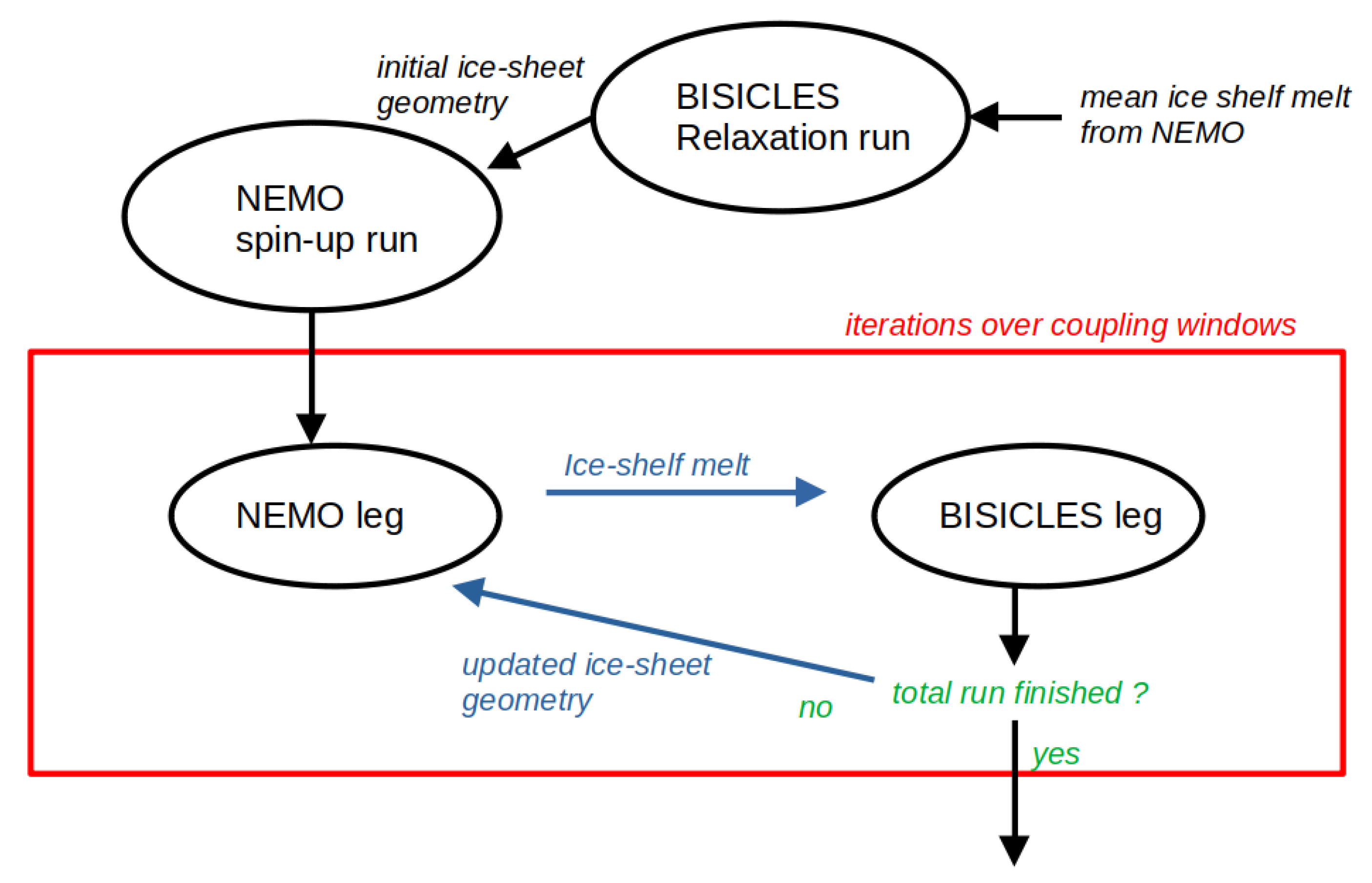

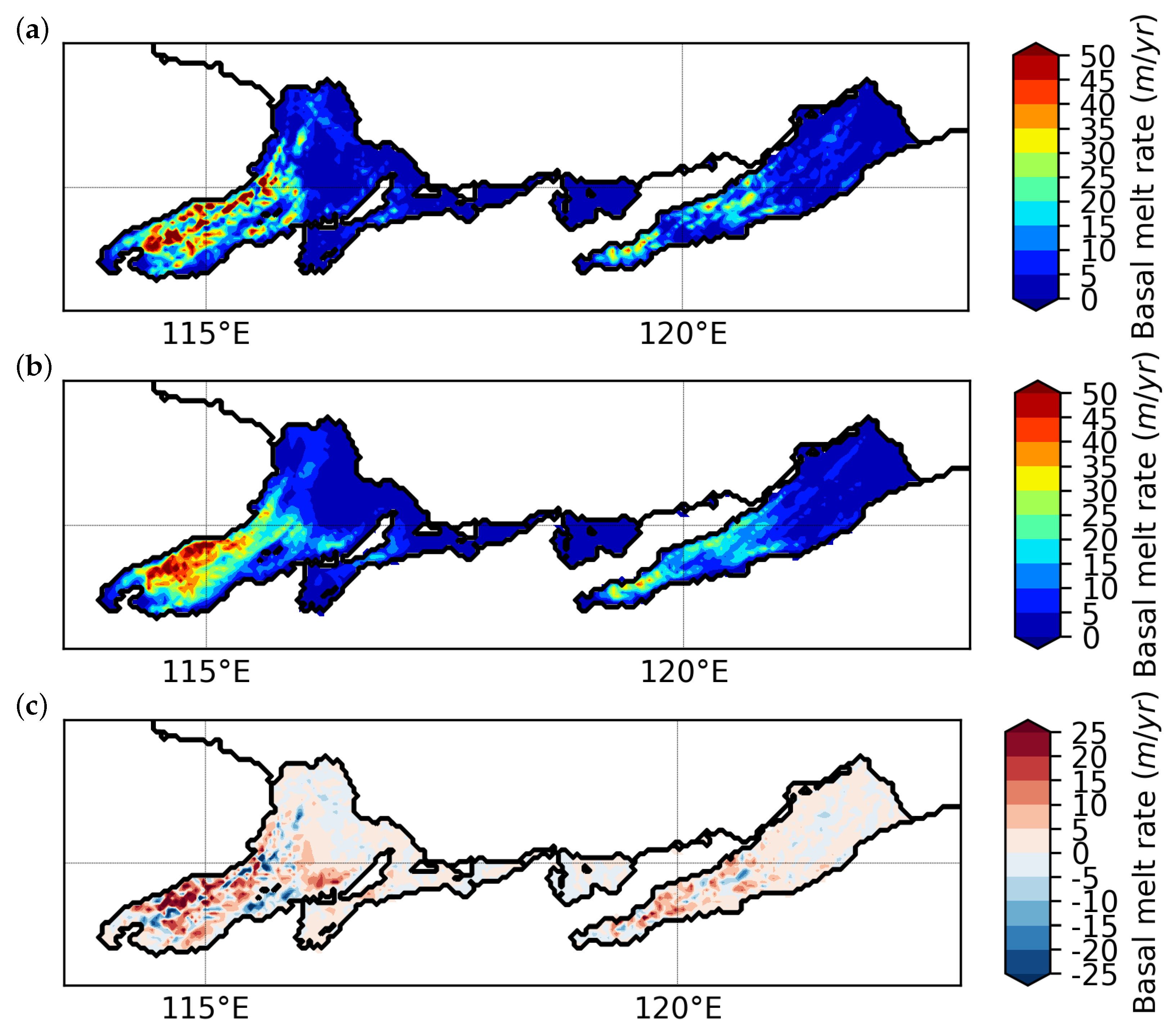
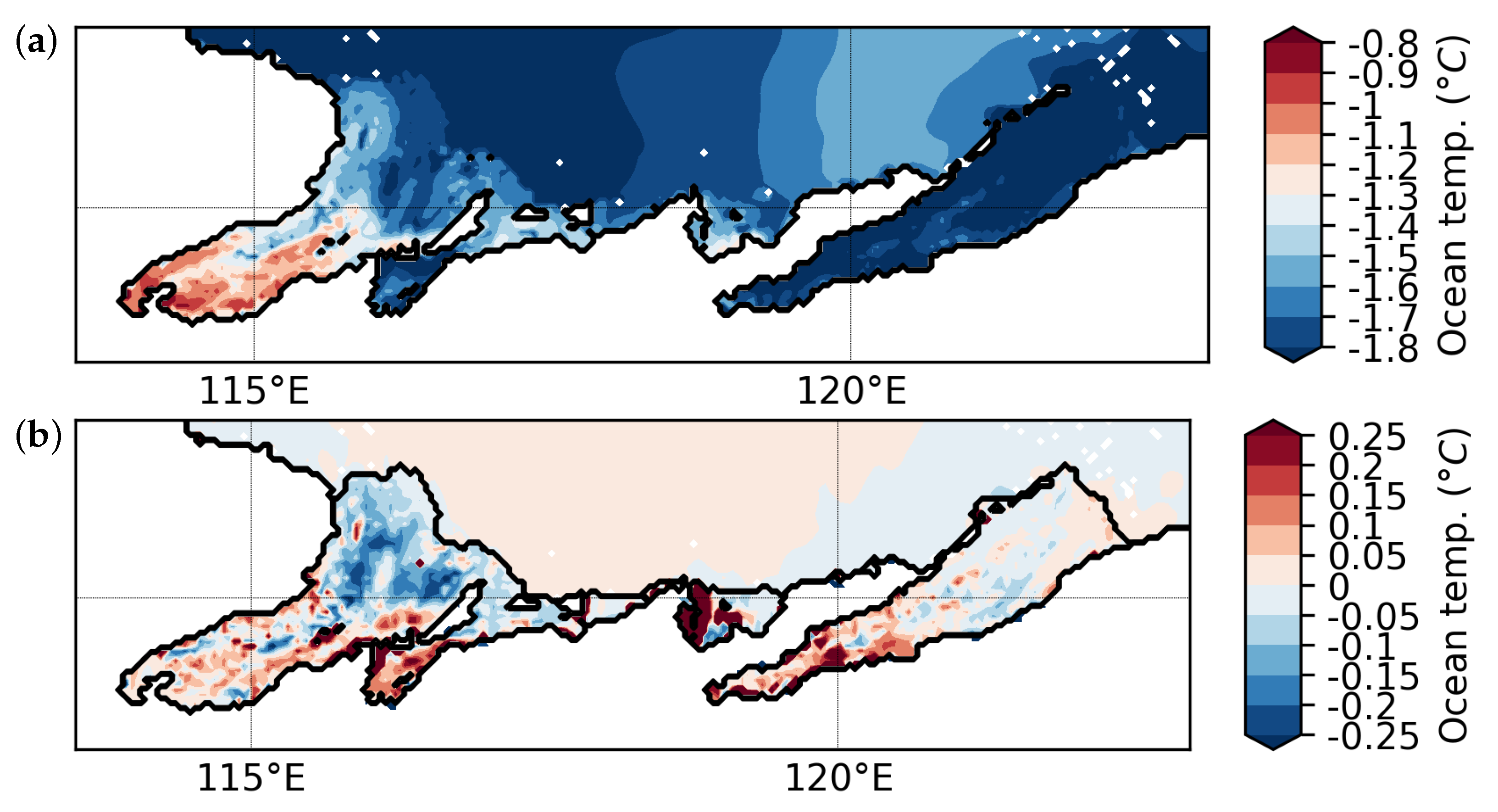
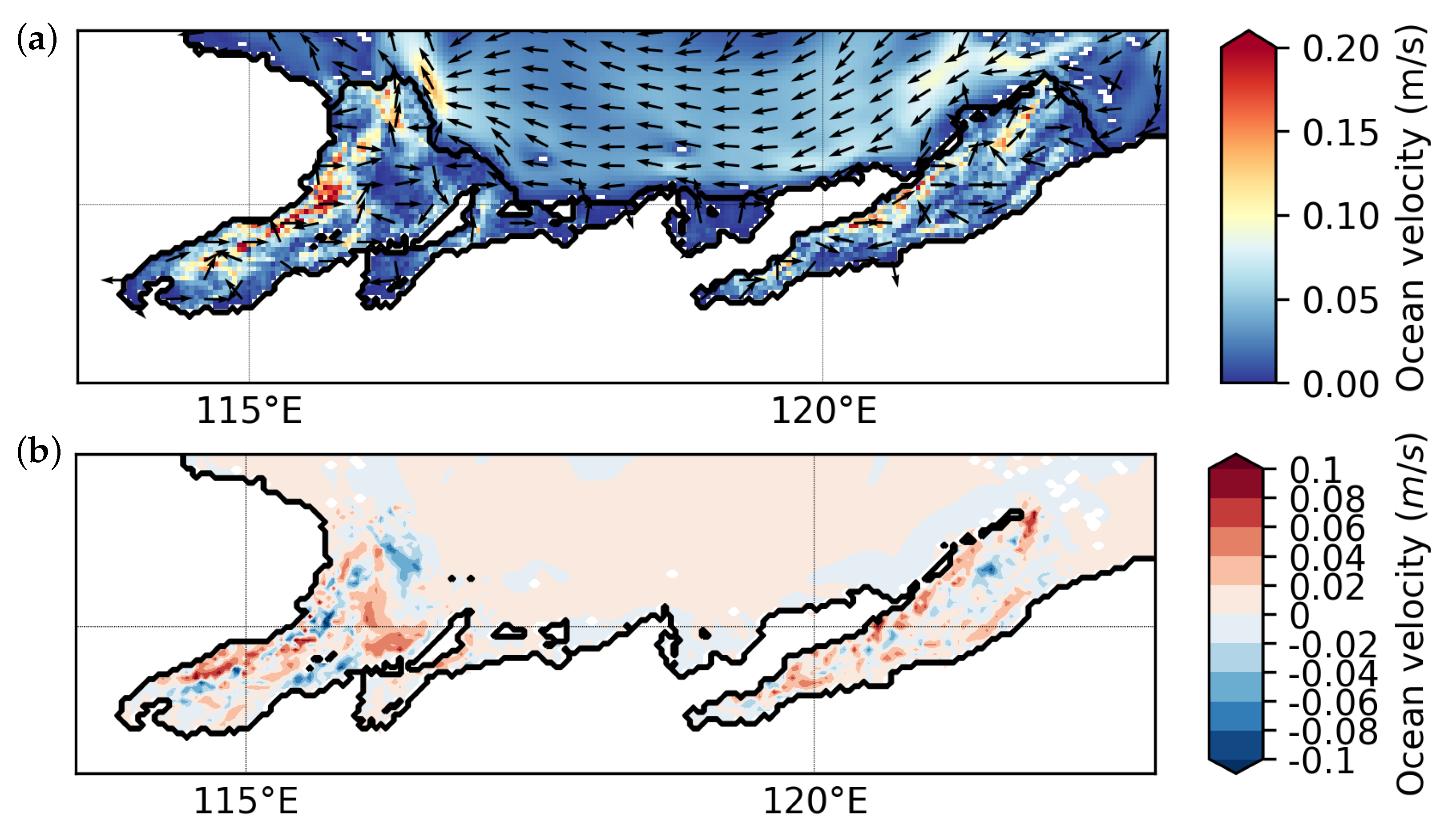
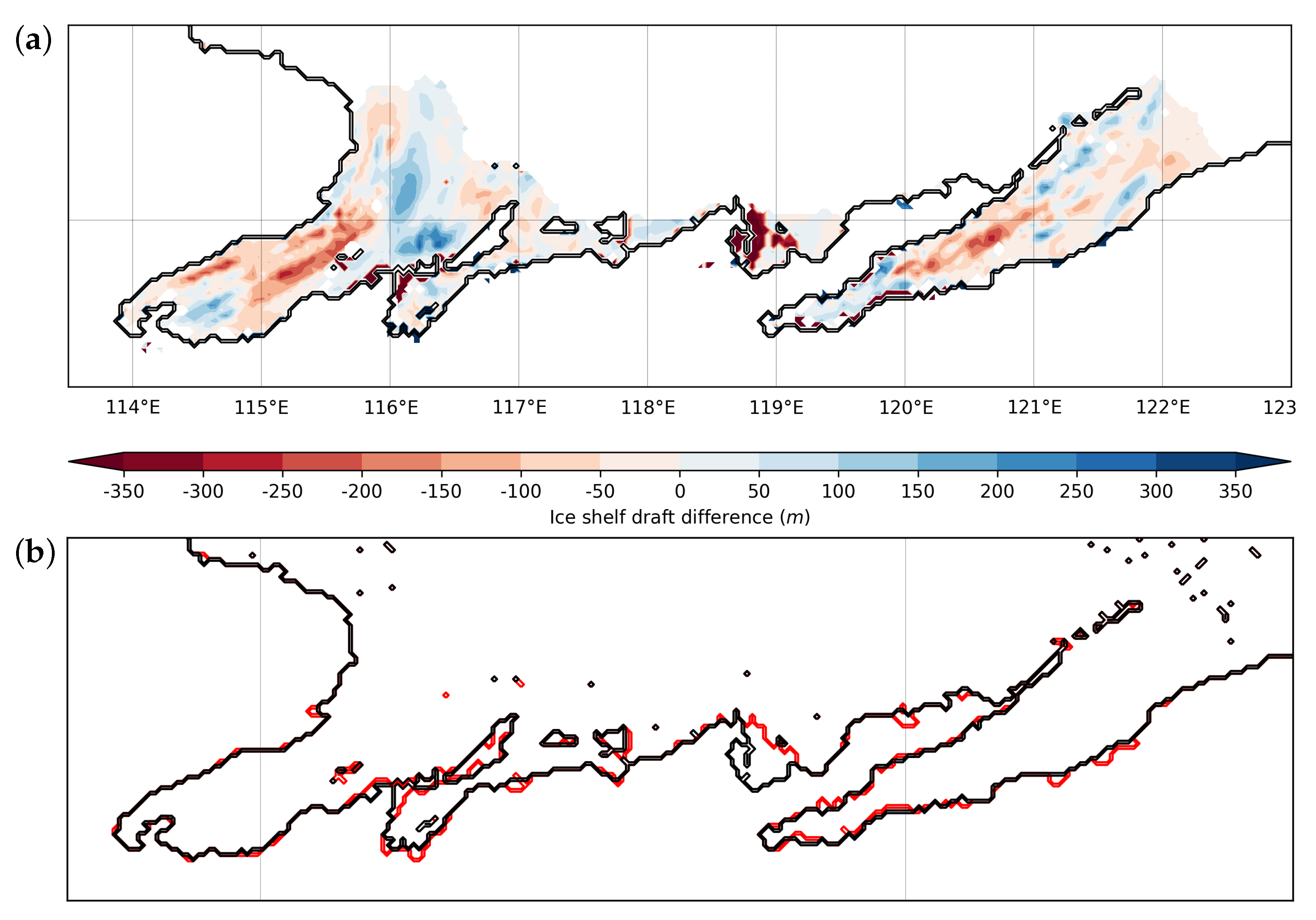
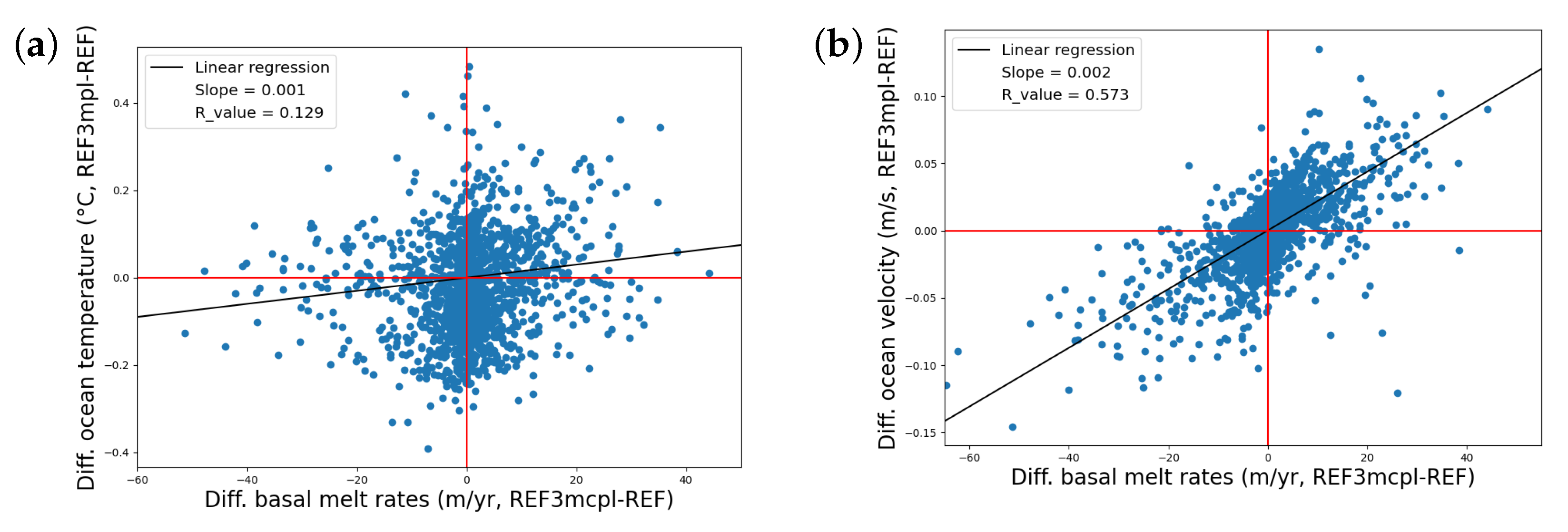
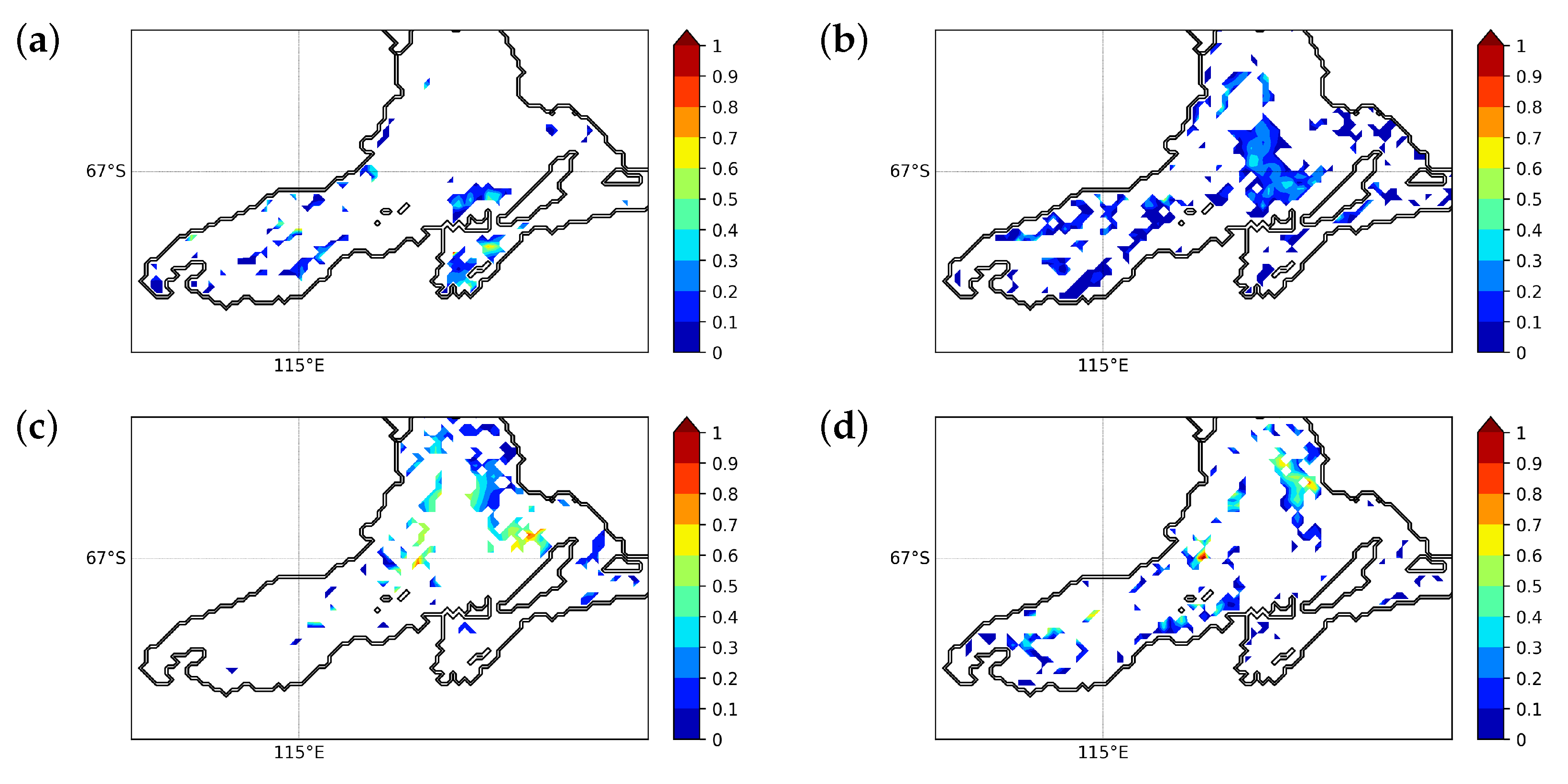

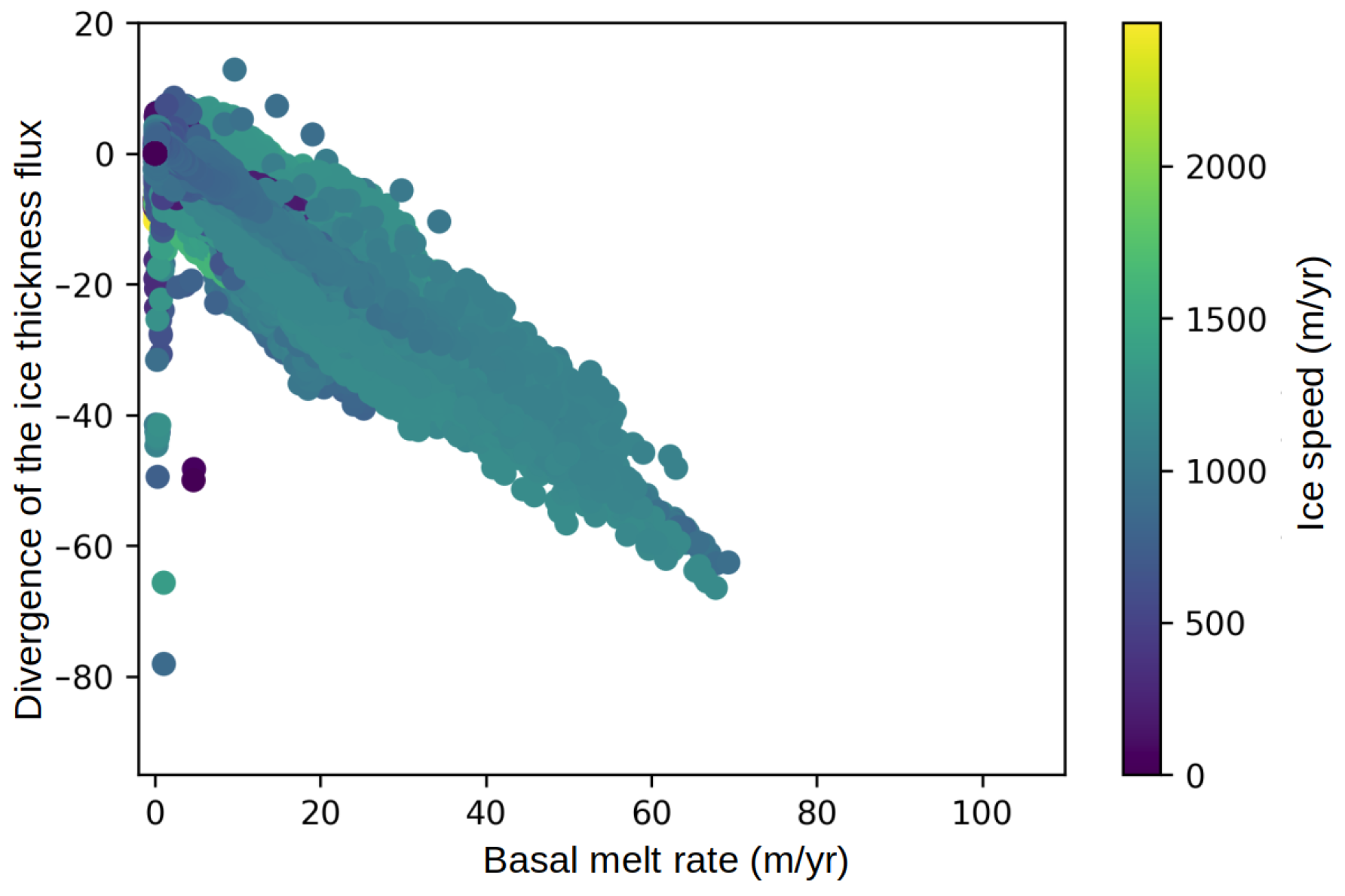

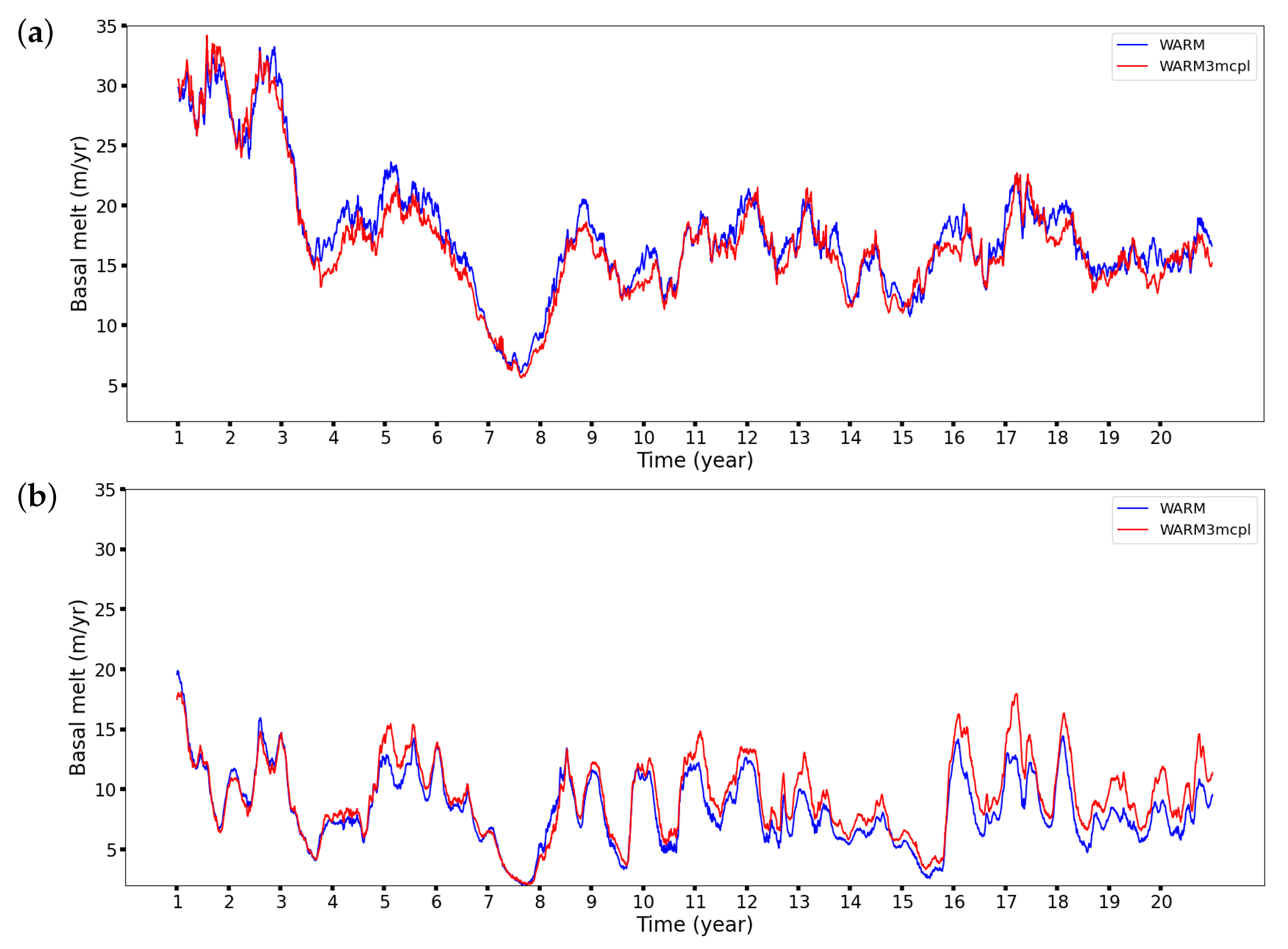
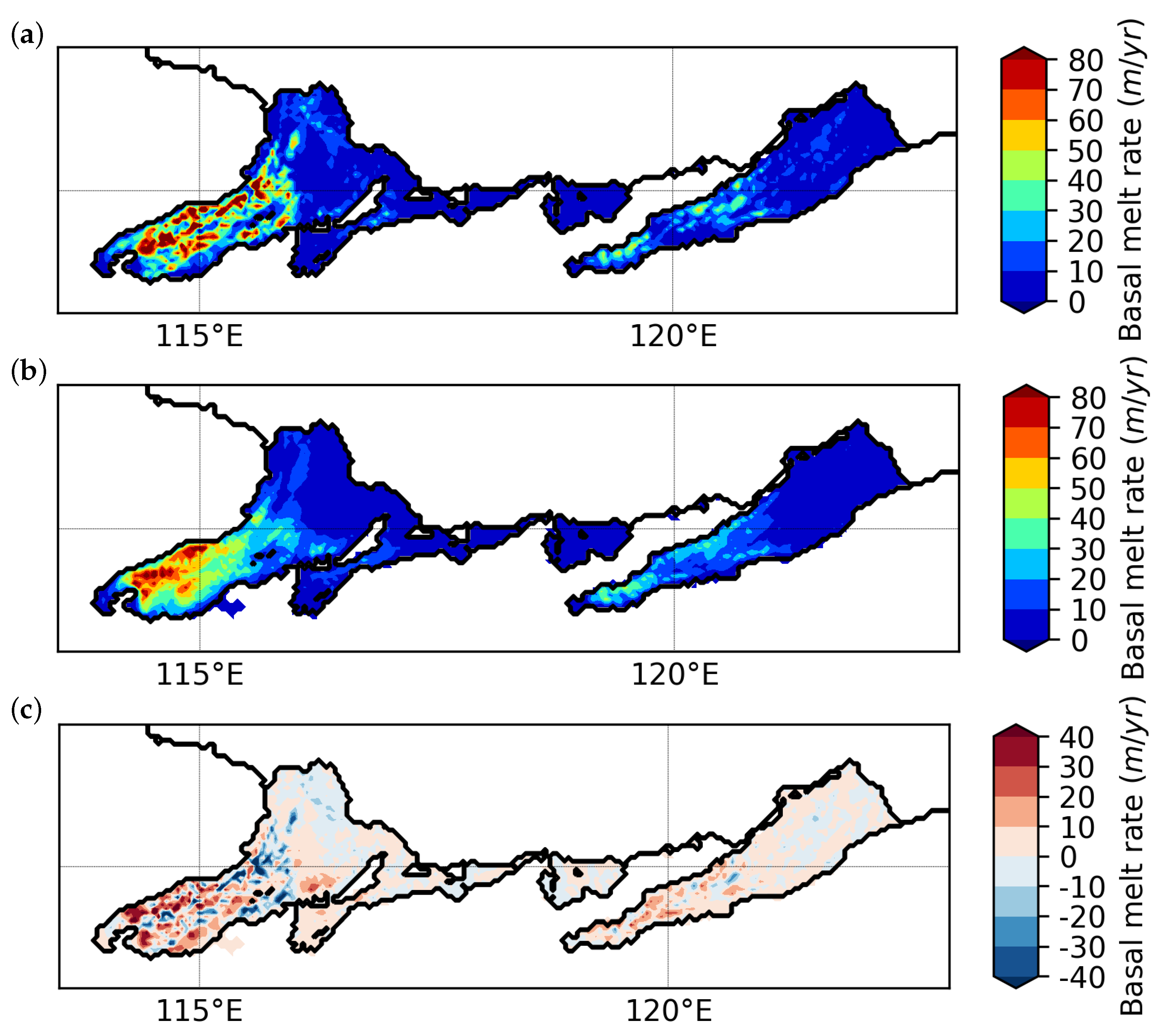
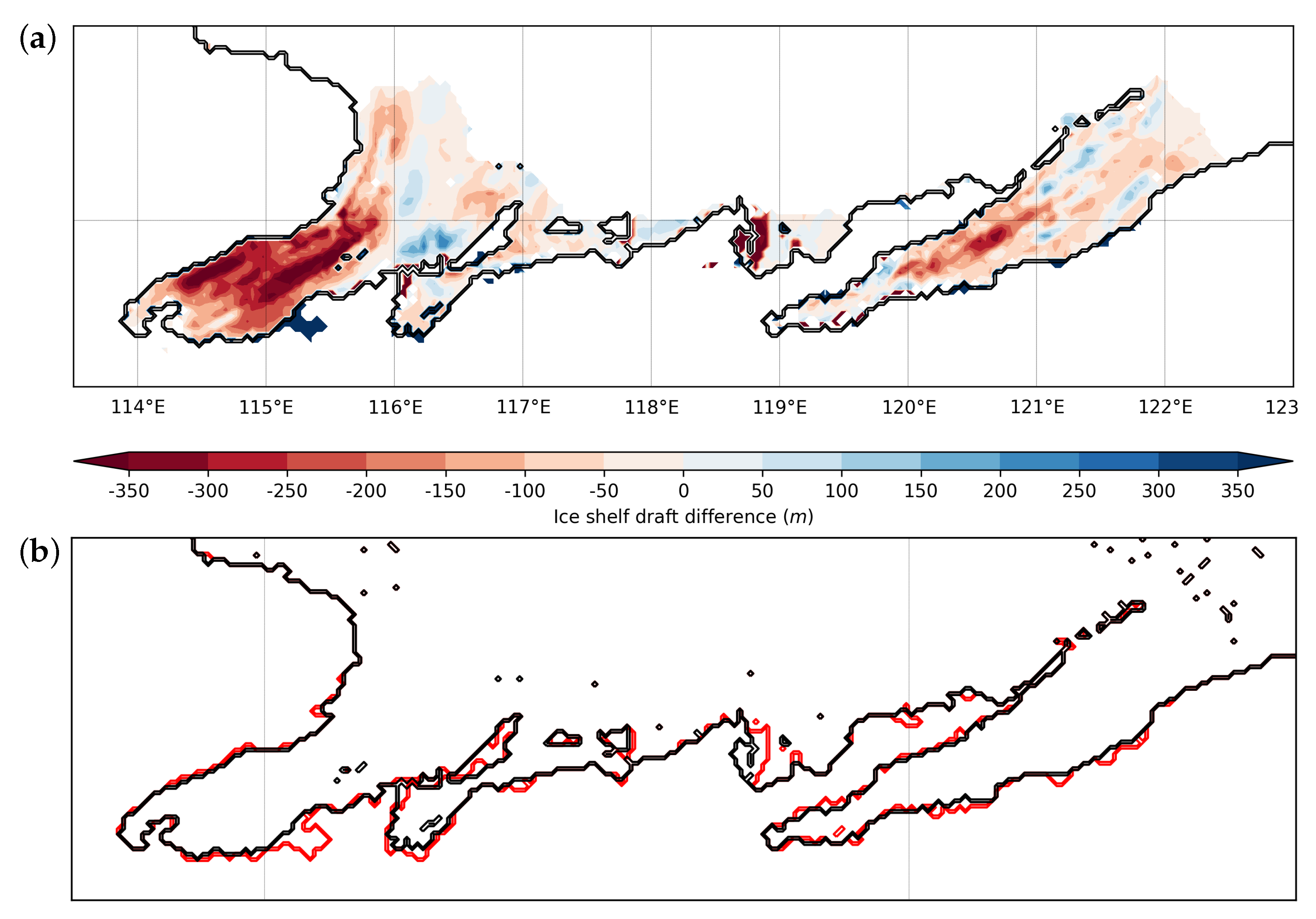
| Model | Forcing and Lateral Boundary Conditions | |
|---|---|---|
| REF | NEMO stand-alone | Recent past (ERA5, PARASO, 1995–2014) |
| REF3mcpl | BISICLES–NEMO coupled | Recent past (ERA5, PARASO, 1995–2014) |
| WARM | NEMO stand-alone | REF + anomalies derived from EC-Earth3 (2081–2100) |
| WARM3mcpl | BISICLES–NEMO coupled | REF3mcpl + anomalies derived from EC-Earth3 (2081–2100) |
Disclaimer/Publisher’s Note: The statements, opinions and data contained in all publications are solely those of the individual author(s) and contributor(s) and not of MDPI and/or the editor(s). MDPI and/or the editor(s) disclaim responsibility for any injury to people or property resulting from any ideas, methods, instructions or products referred to in the content. |
© 2023 by the authors. Licensee MDPI, Basel, Switzerland. This article is an open access article distributed under the terms and conditions of the Creative Commons Attribution (CC BY) license (https://creativecommons.org/licenses/by/4.0/).
Share and Cite
Van Achter, G.; Fichefet, T.; Goosse, H.; Pelletier, C.; Haubner, K.; Pattyn, F. Ocean–Ice Sheet Coupling in the Totten Glacier Area, East Antarctica: Analysis of the Feedbacks and Their Response to a Sudden Ocean Warming. Geosciences 2023, 13, 106. https://doi.org/10.3390/geosciences13040106
Van Achter G, Fichefet T, Goosse H, Pelletier C, Haubner K, Pattyn F. Ocean–Ice Sheet Coupling in the Totten Glacier Area, East Antarctica: Analysis of the Feedbacks and Their Response to a Sudden Ocean Warming. Geosciences. 2023; 13(4):106. https://doi.org/10.3390/geosciences13040106
Chicago/Turabian StyleVan Achter, Guillian, Thierry Fichefet, Hugues Goosse, Charles Pelletier, Konstanze Haubner, and Frank Pattyn. 2023. "Ocean–Ice Sheet Coupling in the Totten Glacier Area, East Antarctica: Analysis of the Feedbacks and Their Response to a Sudden Ocean Warming" Geosciences 13, no. 4: 106. https://doi.org/10.3390/geosciences13040106
APA StyleVan Achter, G., Fichefet, T., Goosse, H., Pelletier, C., Haubner, K., & Pattyn, F. (2023). Ocean–Ice Sheet Coupling in the Totten Glacier Area, East Antarctica: Analysis of the Feedbacks and Their Response to a Sudden Ocean Warming. Geosciences, 13(4), 106. https://doi.org/10.3390/geosciences13040106






